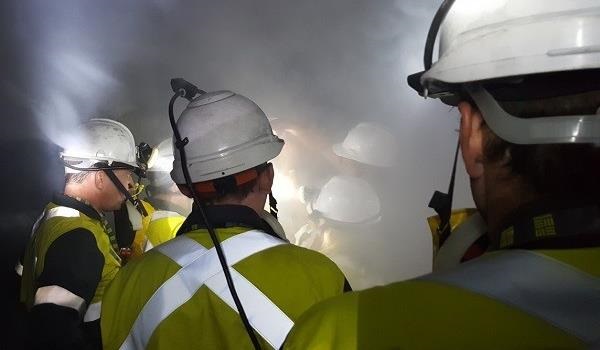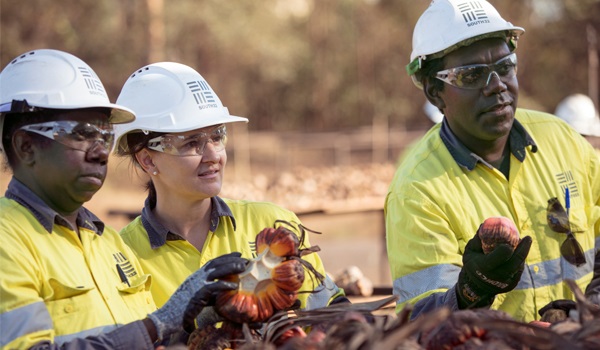Safety

Our approach to health and safety is guided by our Sustainability Policy and defined and implemented through our internal health and safety standards and procedures. The standards and associated procedures are aligned to the International Organisation for Standardisation (ISO) 45001 Occupational Health and Safety Management System Standard 2018, the ICMM Mining Principles: 2 – Decision Making, 4 – Risk Management and 5 – Health and Safety and comply with local laws and regulations.

We are continuing to implement our Group-wide Safety Improvement Program, a multi-year global program of work launched in FY22.
The Program drives culture transformation through four workstreams:
Read more about our Safety Improvement Program in our 2023 Sustainable Development Report.
Our system of risk management enables us to identify and manage threats and opportunities. We use it to support the delivery of our business goals and act on our commitment to everyone going home safe and well.
We have simple risk processes, fit for purpose tools and intuitive technology. These combine to enable continuous and dynamic risk management activities. Our material risk management outcomes inform the key decisions that support the steady performance of our operations. Our focus on management of health and safety risk exposures helps us manage the wellbeing of our workforce through safe and sustainable practices on our sites.
Our risk management approach is supported by the Three Lines Model which includes health and safety checks and reviews, stewardship activities and independent assurance on safety controls, measures and performance.
Our risk and event management system, Global360, supports our workforce to proactively identify and report hazards and events. We investigate incidents with fatality and serious injury potential to capture learnings and improve our controls. Relevant risks, and the controls required to manage those risks, are recorded in the system and risk and control owners assigned. Global360 is used to capture event and hazard investigations and to assign actions to address findings from these investigations. We strive to create enduring value through strong governance and management of our performance. To achieve this, we apply the Three Lines Model in relation to the management of risk:
Strong safety performance depends on our workforce being adequately trained and equipped with the right competencies for the work they do.
Training frameworks are developed and regularly reviewed in accordance with our internal training standard. Job-related competencies are incorporated into our training and skills analysis, in line with our internal safety standard and as required by local laws. Skills matrices are developed and reviewed at least every two years, to identify capability development requirements, including training requirements for material safety risks.
Our operations provide health and safety induction for all new employees and contractors, covering training on potential material health and safety exposures in the workplace.
Employees are engaged on safety issues through office and operation-specific health and safety committees. These typically include peer-appointed health and safety representatives who promote health and safety improvement initiatives and participate in meetings and investigations. These committees, and all employees and contractors, are encouraged to speak up and escalate health and safety issues.
All members of our workforce, including employees and contractors, are empowered and expected to take action (including by stopping work) when there is a potential or actual threat to health and safety. Workers are protected against reprisal for reporting a work-related hazardous situation or acting on a safety concern. These mechanisms are embedded in our internal safety standard and outlined in our Speak Up Policy.
Our frontline leaders play a critical role in embedding our values and culture, by modelling exemplary behaviours and fostering a safe and inclusive work environment.
We continued to develop leadership capability through our Leadership Fundamentals Program. .
As part of our Safety Improvement Program, our LEAD Safely Every Day training builds safety leadership capability through workshops and coaching for senior leaders, managers, superintendents and supervisors across all operations and functions. Read more about our LEAD Safely Every Day training in our 2023 Sustainable Development Report.
We engage dedicated and professionally trained security teams to protect our people and assets at our operations. By holding these security providers to high standards of conduct, we believe they can have a positive impact on local governance, peace and stability.
Globally, all our security providers must verify and comply with the Voluntary Principles on Security and Human Rights (VPSHR), additionally, all private security providers must meet the requirements of the International Code of Conduct for Private Security Providers.
These requirements are mandated in our internal standards which form part of our company assurance programs. Our asset protection management standards acknowledge the importance of developing and maintaining good community relations as a part of successful security risk management. We make our training on the VPSHR available for security providers.

Potential health risks at our operations and projects include exposure to airborne contaminants and hazardous substances, non-ionising radiation and communicable and infectious diseases. Other health risks include noise and ergonomic stressors. We have defined minimum controls to manage exposure to these potential risks in the workplace.
Developments in the management of material workplace and environmental exposures are monitored to inform our approach and occupational exposure trigger levels. We also monitor and manage potential exposures as a consequence of our operations for the communities near our operations.
Health and wellbeing are actively promoted in our workplaces. We aim to create an environment that supports the health and wellbeing of our people and to protect them from potential workplace exposures and physical health impacts.
Employees and contractors have access to occupational health services to prevent and detect early-stage adverse health effects from workplace exposures. Non-occupational employee health services cover chronic disease management, education, and referral for non-occupational related conditions.
We provide risk-based preventative health measures at our workplaces, including, but not limited to, access to fitness facilities, influenza and COVID-19 vaccines, and malaria and HIV/AIDS programs.
Our commitment that everyone goes home safe and well includes mental health. We progressed our activities on health and wellness to a more holistic psychosocial health approach. Our Employee Assistance Program and mental health initiatives are designed with the aim of keeping our people feeling safe and valued. We support mental health and wellbeing through tailored programs.
Community health risks are identified and managed in accordance with our internal health standard. Health monitoring programs at our operations examine baseline and impact assessments and the potential impacts of operational exposures and emissions. We engage health providers and our community programs provide community health support and education for health issues such as malaria, HIV/AIDS and the management of communicable diseases.
In FY23 we further increased our monitoring and management of community health exposure, focusing on the impact of manganese dust in the communities near our manganese mining operations.
Controls to manage low level dust exposure to communities include real-time environmental monitoring and trigger action response plans; dust control systems including extraction and suppression systems and fugitive dust emission controls on unpaved roads. We also continue to progressively rehabilitate disturbed areas, plant vegetation in boundary areas and engage with communities.